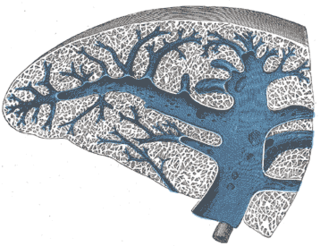 W
WThe spleen is an organ found in virtually all vertebrates. Similar in structure to a large lymph node, it acts primarily as a blood filter. The word spleen comes from Ancient Greek σπλήν (splḗn).
 W
WAn accessory spleen is a small nodule of splenic tissue found apart from the main body of the spleen. Accessory spleens are found in approximately 10 percent of the population and are typically around 1 centimetre in diameter. They may resemble a lymph node or a small spleen. They form either by the result of developmental anomalies or trauma. They are medically significant in that they may result in interpretation errors in diagnostic imaging or continued symptoms after therapeutic splenectomy. Polysplenia is the presence of multiple accessory spleens rather than one normal spleen.
 W
WBanti's syndrome, named for is Guido Banti., is a chronic congestive enlargement of the spleen resulting in premature destruction of the red blood cells by the spleen.
 W
WThe marginal zone is the region at the interface between the non-lymphoid red pulp and the lymphoid white-pulp of the spleen.
 W
WThe red pulp of the spleen is composed of connective tissue known also as the cords of Billroth and many splenic sinusoids that are engorged with blood, giving it a red color. Its primary function is to filter the blood of antigens, microorganisms, and defective or worn-out red blood cells.
 W
WA splenic injury, which includes a ruptured spleen, is any injury to the spleen. The rupture of a normal spleen can be caused by trauma, such as a traffic collision.
 W
WSpleen pain is a pain felt from the left upper quadrant of the abdomen or epigastrium where the human spleen is located or neighboring.
 W
WThe fibroelastic coat of the spleen invests the organ, and at the hilum is reflected inward upon the vessels in the form of sheaths. From these sheaths, as well as from the inner surface of the fibroelastic coat, numerous small fibrous bands, the trabeculae of the spleen, emerge from all directions; these uniting, constitute the frame-work of the spleen.
 W
WThe trabecular veins are the largest veins inside the spleen. It drains the blood collected in the sinuses of the pulp.
 W
WWandering spleen is a rare medical disease caused by the loss or weakening of the ligaments that help to hold the spleen stationary. Wandering spleen is also called displaced spleen, drifting spleen, splenoptosis, floating spleen, or splenic ptosis.
 W
WWhite pulp is a histological designation for regions of the spleen, that encompasses approximately 25% of splenic tissue. White pulp consists entirely of lymphoid tissue.